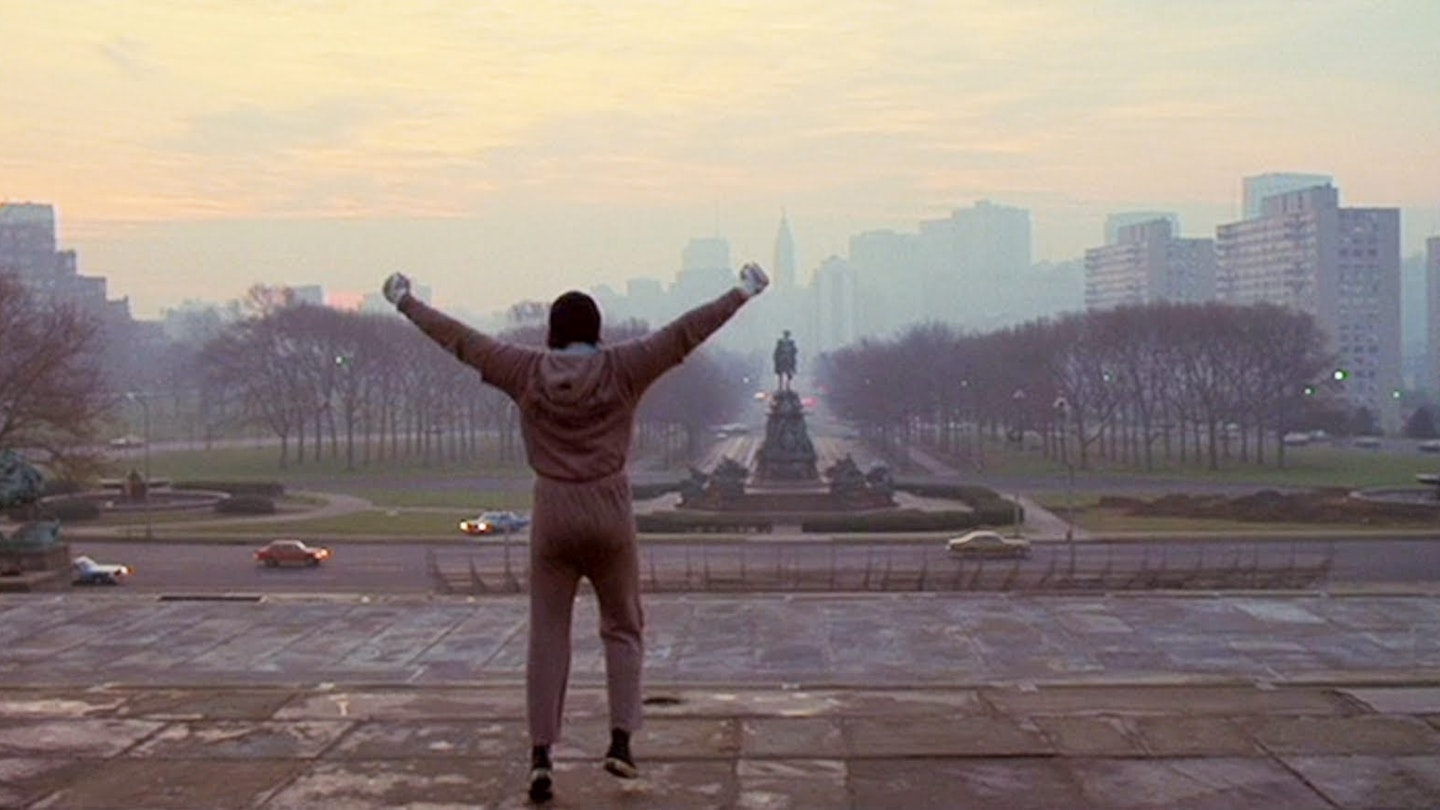Sylvester Stallone's entire career has been all about beating the odds and continuously proving that it ain't about how hard you get hit, it's about how hard you can get hit and keep on going.
Well, Rocky's taken some hits, but he's still going strong 40 years after first stepping into the ring and then seeing Rocky win 1976's Best Picture. Give the man his due: Stallone may not have taken home the Academy Award for Best Supporting Actor in Creed, but his veteran pugilist has definitely gone the distance.
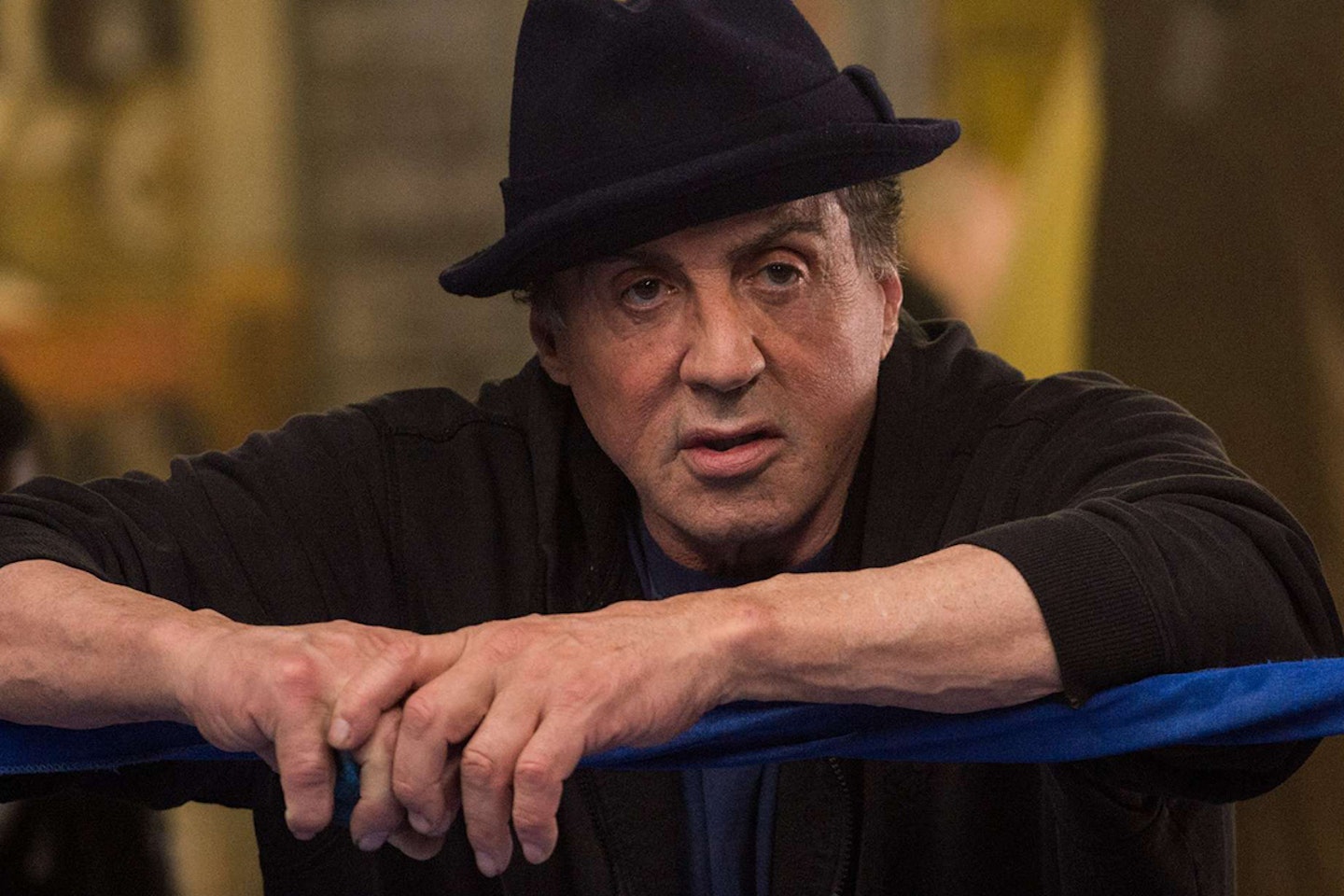
To celebrate his nomination and the 40th anniversary of Rocky, Empire offers this complete history.
ROUND ONE: INTRODUCTION
Time for a history lesson: Rocky won three 1976 Academy Awards, one each for direction (John Avildsen), editing (Richard Halsey and Scott Conrad), and the aforementioned Best Picture of the year (carried off by producers Robert Chartoff and Irwin Winkler).
Rocky not only launched Stallone’s career as an actor and filmmaker, it touched a chord with a generation of moviegoers. Each subsequent entry in the series (with the exception of the they’ve-answered-the-bell-once-too-often Rocky V) was more successful than its immediate predecessor. Additionally, it turned actors Talia Shire (Yo, Adrian!), Burt Young (“I don’t sweat you” Paulie), Burgess Meredith (Mickey “You’re gonna eat lightning and crap thunder” Goldmill) and Carl Weathers ('Master Of Disaster' Apollo Creed) into household names, and unified audiences in booing a couple of formidable threats (Mr. T’s 'Clubber' Lang, Dolph Lundgren’s Ivan Drago), and one not so formidable (Tommy Morrison’s Tommy Gunn).
Despite its dedicated boxing backdrop, the Rocky films appeal to the underdog in each of us; the subconscious part of our minds that remains convinced - no matter how stacked against us the odds are - that we could go the distance if only we were given the opportunity.
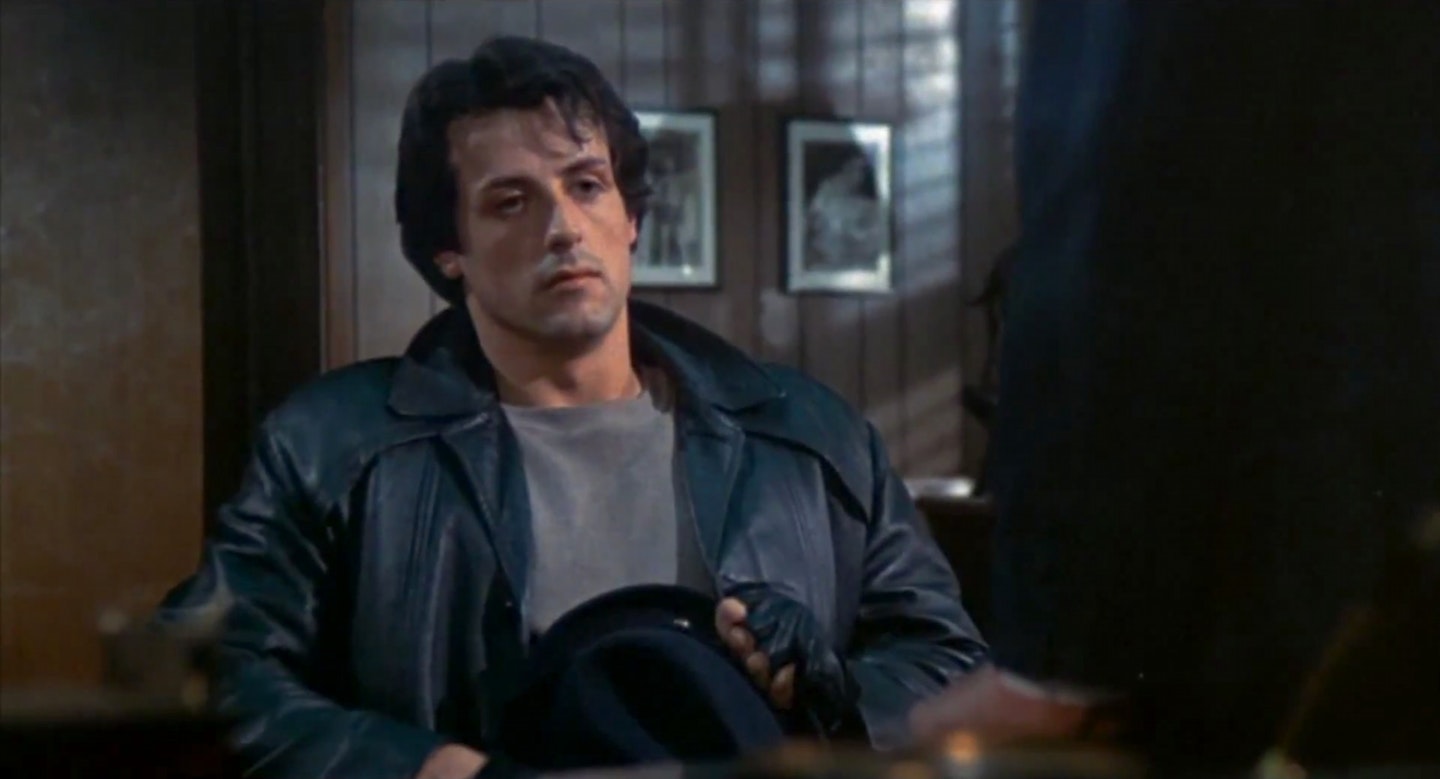
ROUND TWO: THE STORY
John Avildsen (director): Originally, a friend of mine had brought Sylvester to the producers as an actor, and during that audition he said, “I also write.” They said, “Let’s see something you’ve written,” so he showed them a script he wrote called Paradise Alley, which they liked and wanted to buy. He said, “Somebody’s already bought that, but I’ll write you another one.” He went away and about two days later he brought back Rocky, and that’s how it happened.
Sylvester Stallone (screenwriter, Rocky Balboa): I was just about broke and things were looking very, very bad. One night, to cheer myself up, I took the last of my entertainment money and went to see the Muhammad Ali/Chuck Wepner fight. I was watching the fight in a movie theatre… Chuck Wepner, a battling bruising type of club fighter who never really made the big time, was now having his shot, but the fight was not regarded as a serious battle. It was called a public joke. I’m sitting there, looking around at the audience and a drama is unfolding. Wepner’s hanging in there. And then, all of a sudden, Ali falls down – he tripped – but now the place is going crazy. And here comes the last round and Wepner finally established himself as one of the few men who had ever gone the distance with Muhammad Ali. I am sure that moment meant more to him than any money he ever could receive from fighting, because now he had run the complete circle. This is why he had been training for 34 years. I said to myself, “That’s drama. Now the only thing I’ve got to do is get a character to that point and I’ve got my story.”
Robert Chartoff (producer): From my point of view, the appeal of the script was the fact that Rocky lost the fight. That was the key element for me and after I finished the script I immediately said, “This is a movie that I want to make.” It was so off the track from everything else that one reads. The hero actually loses and is still a hero and still has good values and he had his own internal battle that he had fought. I liked that idea a lot.
Stallone: There are certain parallels between Rocky and me. Rocky had drive and intelligence and the talent to be a fighter, but nobody noticed him. The second ingredient had to be me, my particular story, my inability to be recognised. I felt Rocky to be the perfect vehicle for that kind of sensibility. So I took my story and injected it into the body of Rocky Balboa because no-one, I felt, would be interested in listening to or watching or reading a story about a down-and-out, struggling actor/writer.
Avildsen: A friend of mine sent the script to me and he had to convince me to read it because I had no interest in boxing. I thought it was a dumb sport. But he asked me to do him a favour and read it. And I had met Sylvester a couple of times before when he would come in and audition for different movies I was doing. So I read it, and on the second or third page this guy was talking to his turtles Cuff and Link and I was charmed. I found it to be a terrific character study with boxing as a background just like the Civil War was the background of Gone With The Wind. I never figured this story was about boxing; it was about this guy who had a dream and I was very taken by it.
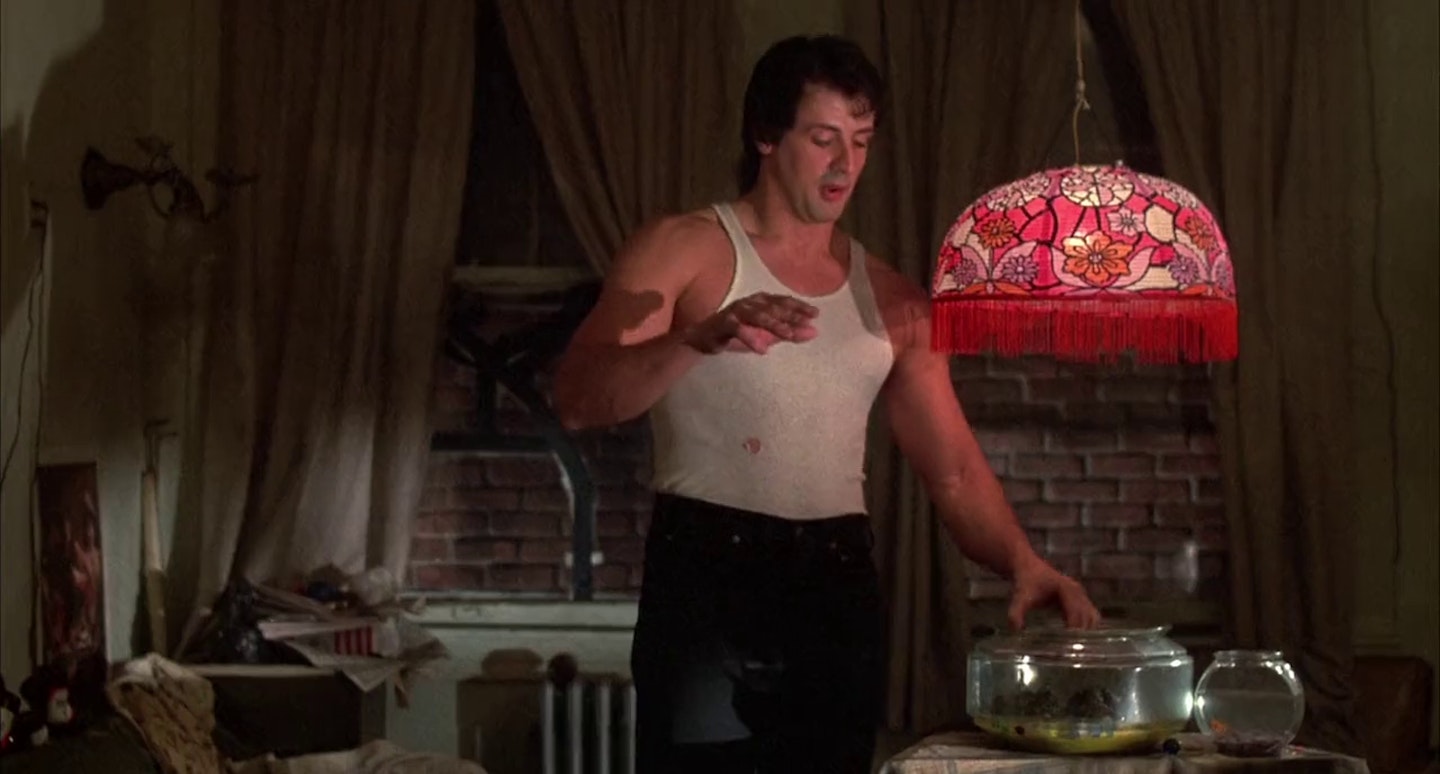
ROUND THREE: REFUSING TO SELL OUT
Avildsen: A number of people wanted to star in the film, but much to Stallone’s credit he said, “Nothing doing. I play it or nobody does.” He was a starving actor at the time, so he didn’t have a lot of options.
Chartoff: Getting Sly to star in the film was not difficult, despite anything you might have heard over the years. The studio just didn’t care that much whether or not we made the picture. I think they were hoping we would forget about it. What had happened was that Irwin Winkler and myself had just signed a long-term commitment with United Artists to make films. They were hoping that we would fill a niche of making big-name films. We had just made New York, New York for them and they wanted us to make substantial pictures, but then we brought in this little film with “Who? Sylvester what?” Obviously they didn’t have any strong feelings about making it. It was something that we wanted to make, and it was probably because we were just starting fresh with the studio and were committed to doing it that they agreed to do it. But there was never any question in my mind that Sylvester Stallone was going to be starring in it, in spite of all of the mythical stories you might hear. Making a million dollar picture with Stallone, that’s what it was all about.
ROUND FOUR: CASTING
Avildsen: A lot of people came in to audition for the role of Mickey, the trainer. I wouldn’t hire anybody unless they auditioned and I liked them. Lee J. Cobb came in and he wouldn’t audition. We got Lee Strasberg to audition. Then Burgess [Meredith] came in and they read the scene where Rocky is told that he has to get out of his locker. He read the scene a few times and then I said, “Why don’t you guys go through the scene and do it in your own words?” So they did, and at the end Rocky is walking away, dejected, and Burgess yells, “Hey, did you ever think about retiring?” Stallone doesn’t know what to say to him, so he says, “No,” and Burgess says, “Well, start thinking about it.” That was just perfect, and that’s how he got the job.
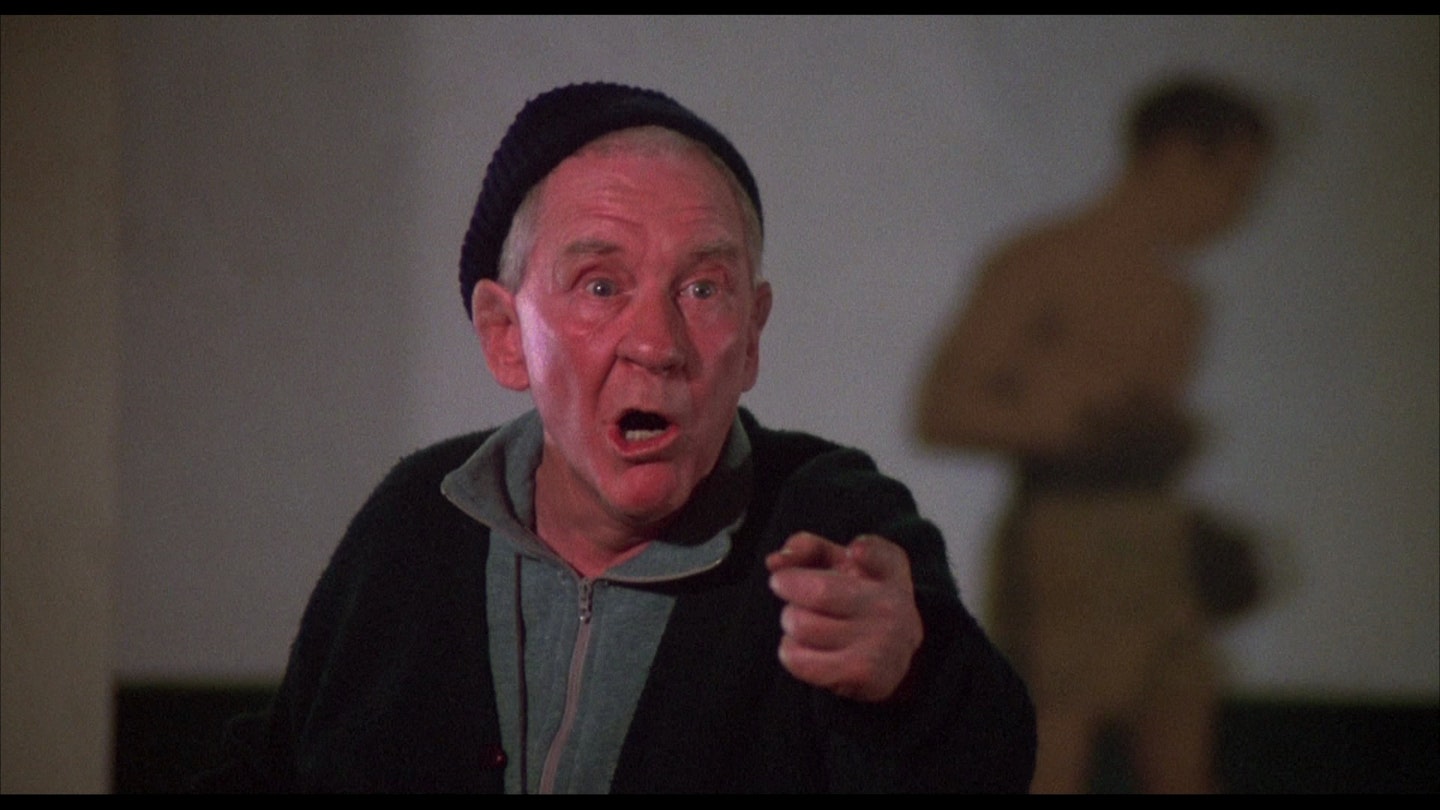
Chartoff: Burgess was always my first choice, but he wasn’t really the first choice for the picture. We went to Lee first. They had just made Godfather II and he was very hot – he had gotten a nomination for the picture – and we gave him the script. He would have been wonderful for the role as well, but he wanted far more than we could afford to spend. He was hot, this was his moment in the sun, but he wanted about $100,000, which was one tenth of our budget. I felt this was an opportunity to take the script to Burgess. He told me that he read the script that night and, of course, loved the part. But he got a call that same evening from his buddy Lee Strasberg. He had literally just finished reading the script and he said to Lee, “What’s up with you?” and Lee said, “I’m doing this wonderful movie called Rocky.” Burgess didn’t say anything, of course, and thank goodness he did the film.
Avildsen: For Adrian we looked for the longest time. Finally we decided on Carrie Snodgress, but her agent wanted more money than we had to give and that was the end of Carrie. Then Talia Shire walked in and she was just terrific. I think she was the last major role that we cast.
Chartoff: Talia hadn’t been our first choice, but once again there was a matter of money and Carrie Snodgress wanted too much. The moment we saw her – at least as far as I was concerned – there was no question that Talia was absolutely the right person.
Talia Shire (Adrian): When they introduced me to Sylvester Stallone, he came into the room backwards and I thought, “What an unusual guy,” but that relationship, playing each with the other, in that audition had that right chemistry. I even punched him in the arm and apparently that cinched the job.
Avildsen: Burt Young was a given [to play Paulie]. United Artists had just done Killer Elite and Burt was in that. [UA’s] Arthur Krim thought he was terrific and wanted him to be in the movie. I’d known Burt, so I thought that was a terrific idea.
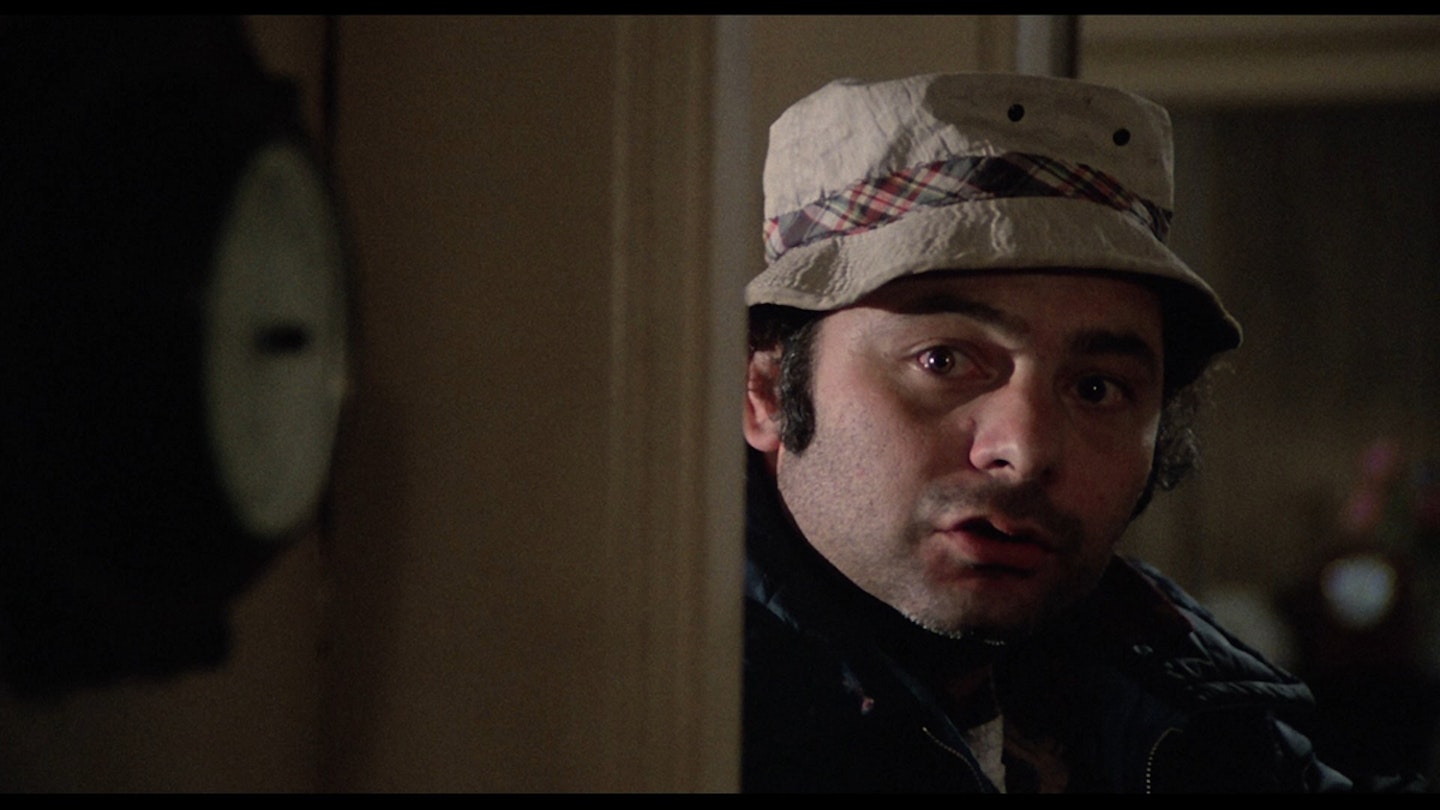
Chartoff: Each part was challenging to fill, except for Burt Young. We knew we wanted Burt from the beginning, because Irwin and I had worked with him on The Gambler and we knew what a wonderful actor he was and how right he would be for this part.
Avildsen: Carl Weathers came in to read for the part of Apollo Creed, and I don’t think he had done much acting before. But he had a great spirit and a lot of arrogance. He didn’t know that Sylvester had written it, he just thought that he was an actor on the film and started complaining about him. He didn’t think Sylvester was very good and was very brash, which Sylvester loved. He said, “This guy is perfect,” and he worked like a real trooper. It was a most harmonious group.
Chartoff: Originally we went to someone like Joe Frazier and we brought him in to spar with Sylvester, and it was obvious that it was impossible. He was a pro, that was his business. He couldn’t act like Stallone and Stallone can’t fight like him. We really found Carl Weathers at the very last minute, and it’s amazing that we were able to get him for the part. It was literally a week before we started principal photography.
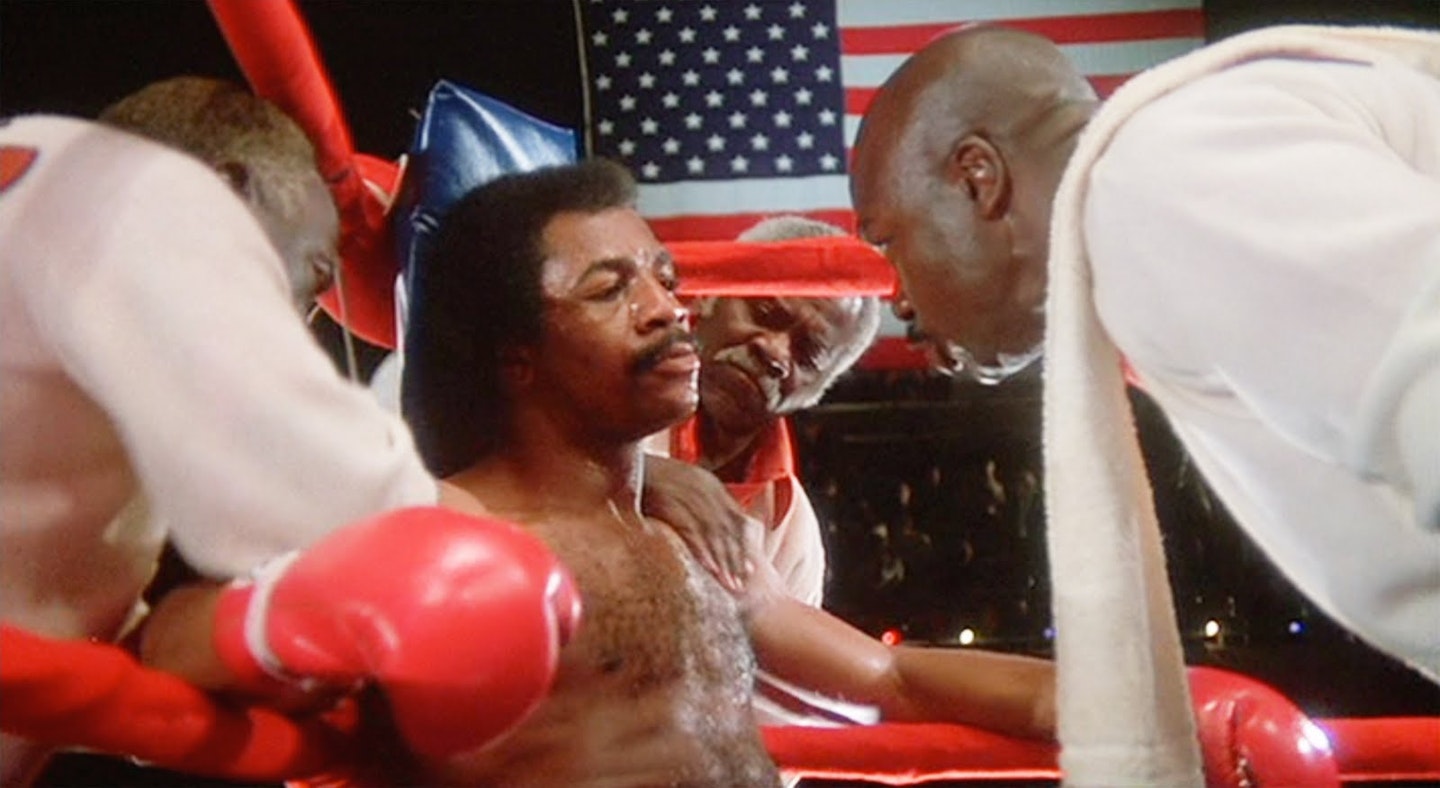
Carl Weathers (Apollo Creed): Not to be blowing my own horn, though I certainly will, I think Sly and I have a chemistry on screen that few actors have been able to match. Redford and Newman have a certain rapport that is just irresistible. People really respond to the relationship. At the same time, I’ve always done my best to distinguish between Carl Weathers the actor and the actor playing the boxer. Apollo Creed is an indelible image, and I happen to be the guy who co-created that image with Sylvester Stallone. It’s something, as far as I’m concerned, which is a part of history.
Avildsen: When the producers went to UA with the script, the studio said, “Who’s this guy Stallone?” and the producers said, “He was just in The Lords of Flatbush,” so the guys at UA checked out that film and they said, “Oh, okay, he’s a good looking guy.” They thought that Stallone was Perry King. They said, “Okay, go make the picture,” and when they started seeing dailies they began asking, “Where’s Stallone?” I said, “That guy.” “No, no, no, Stallone’s blond.” “No, no, no, that’s Stallone.” They said, “Oh, we thought it was the other guy.”
ROUND FIVE: FILMING
Avildsen: The studio didn’t want us to go to Philadelphia because it would be so expensive. I said, “We can just sneak into Philadelphia. I’ll bring the camera and get a crew from New York and it’ll be fine.” So we started shooting in Philadelphia with a non-union crew. Rocky and Adrian’s first date was supposed to be a restaurant, but I said, “We don’t want five or six pages of yakking with two people sitting at a table, let them go bowling, ice skating or something like that.” So we decided on ice skating, because there was an outdoor rink in downtown Philadelphia that was like a poor man’s Rockefeller Center. We were going to do it there, but the producers started getting nervous that the union might find us in Philadelphia, so we went back to Los Angeles before we finished. There, they told us we had to put the scene back in the restaurant because we couldn’t afford all of those extras that would have to be paid union rates. I said, “Maybe there aren’t any extras. Maybe the place is closed and they have to sneak in.” Sylvester liked that idea and that’s how the place came to be empty. So we had a number of instances where we didn’t have the money and we had to come up with other schemes, and it always made it better. Instead of despairing, you say, “How do we turn this to our advantage?”
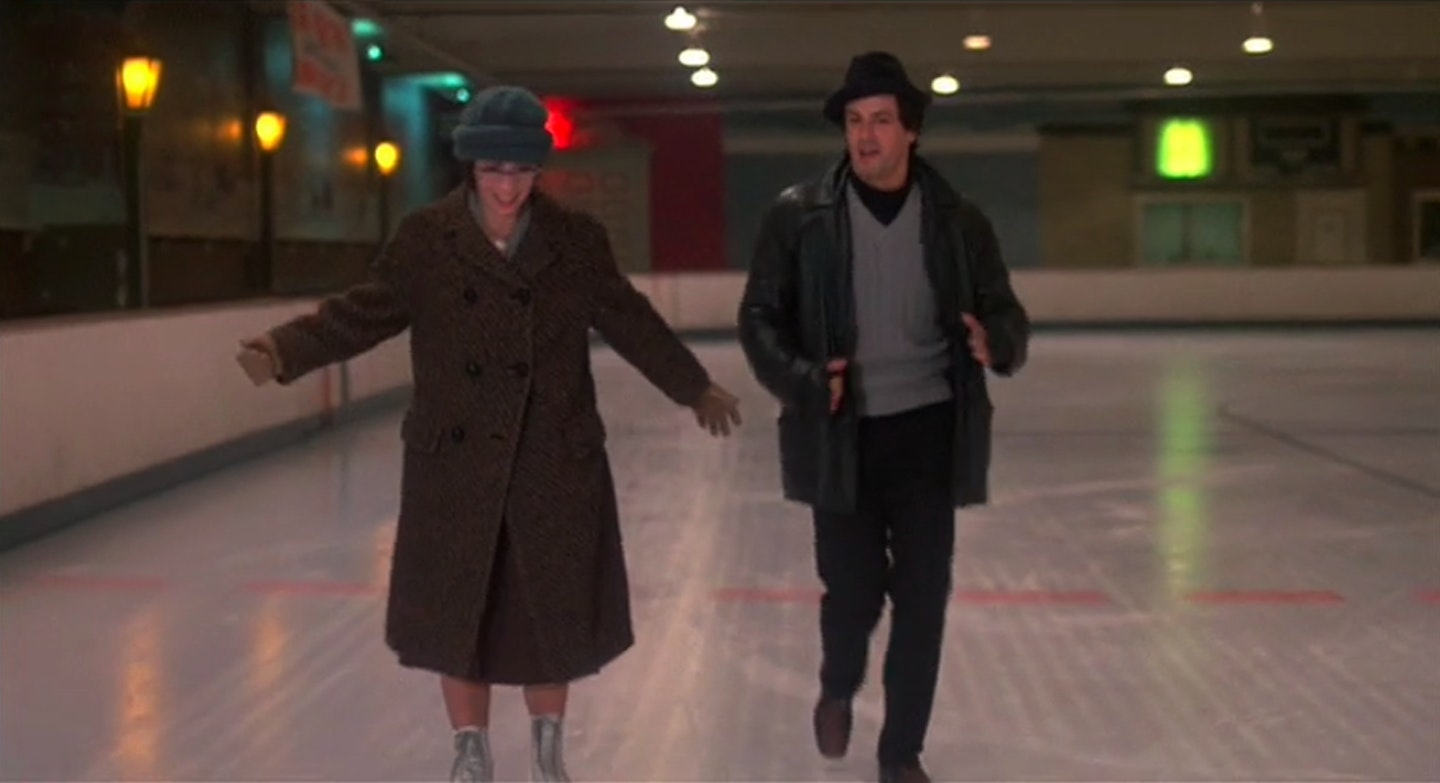
Chartoff: Rocky was great fun to shoot. In part because I think we had to shoot it for a million dollars, it ended up having the qualities that it did. I think if we had too much money, it may not have been the same film. We never would have hired (composer) Bill Conti at that point if someone had given us five million dollars to make the picture. We would have gone along with some standard composer who played it safe rather than played it this way. We didn’t even have an art director until two weeks before the end of the picture, and he got an Academy Award nomination. The union finally forced us to have one. Rather than saying production was hard, in retrospect I would say it was an opportunity and I think it’s the reason that Rocky is what it is.
ROUND SIX: THE FIGHT
Scott Conrad (editor): The fight had 84,000 feet of film and was shot with six cameras. When I say the fight, it’s everything from the time Rocky goes to the arena until the end. Truthfully speaking, that amount of footage is a whole movie in itself. At one point I had to explain why it was taking me three weeks to cut this fight. I explained to them, “Look, I’ve got 84,000 feet of film from six cameras, guys.” Chartoff turned to Winkler and said, “My God, that’s everything we shot on our first movie, Point Blank.” I said, “You got it; that’s the deal, guys.” Cutting the fight was extremely challenging, especially when you think about the fact that we had to cut six cameras’ worth of footage. It is a very overwhelming task, and of course the most important thing is to have it organised and find a way to bring it all together. But the choreography of the fight was excellent. I went back and looked at some earlier boxing films, like Kirk Douglas in The Fighter, and I decided that rather than doing this old-fashioned kind of stylised thing, I wanted to make it look as realistic as possible, like it was an event. The way that the fight began with Carl Weathers coming in on the float he comes in on, it really felt like much more of an event. If I could make people feel that this was something more real, that to me was the better way to do it.

Avildsen: After seeing a number of boxing films, I realised that the boxing usually looked pretty bad. We wanted the final fight to look real, so I was able to get the producers to give us rehearsal time and put the boxing at the end of the schedule so we would have as much time as possible to get it right. On the first day they got into the ring, long before we started to shoot, Sylvester said, “I’ll do this” and Carl Weathers said, “I’ll do that.” I said, “Why don’t you go home and write this thing out: 'left, right, up, down'... whatever you want, and then we’ll learn that like a ballet.” Sylvester liked that idea and he came back the next day with thirty-some pages of lefts and rights. I had my 8mm movie camera and started shooting them do it. I’d show them the footage every day and they’d see how terrible it looked, and came up with ways to make it better and better and we got it down. We knew the first quarter of the first round was here, and the second quarter of the first round was there, and we really got it down. So that by the time it came to shoot it, it looked great.
Richard Halsey (editor): Avildsen and I had a discussion at his house prior to the making of the movie. We watched boxing films and playing classical music and slowed the images down in the projector and we came up with the montage of the fight. It was scripted, but we tried to do it in a stylised way. You know, there’s something about a great boxing match, a great fight, that gets people involved. And this gave the impression of being real. I’ve got to give credit to Sylvester for the way he wrote it, the way the director executed it and the way we edited it. It had a great ending. Certainly one of the elements that worked during that fight was Bill Conti’s score; it was tremendous.
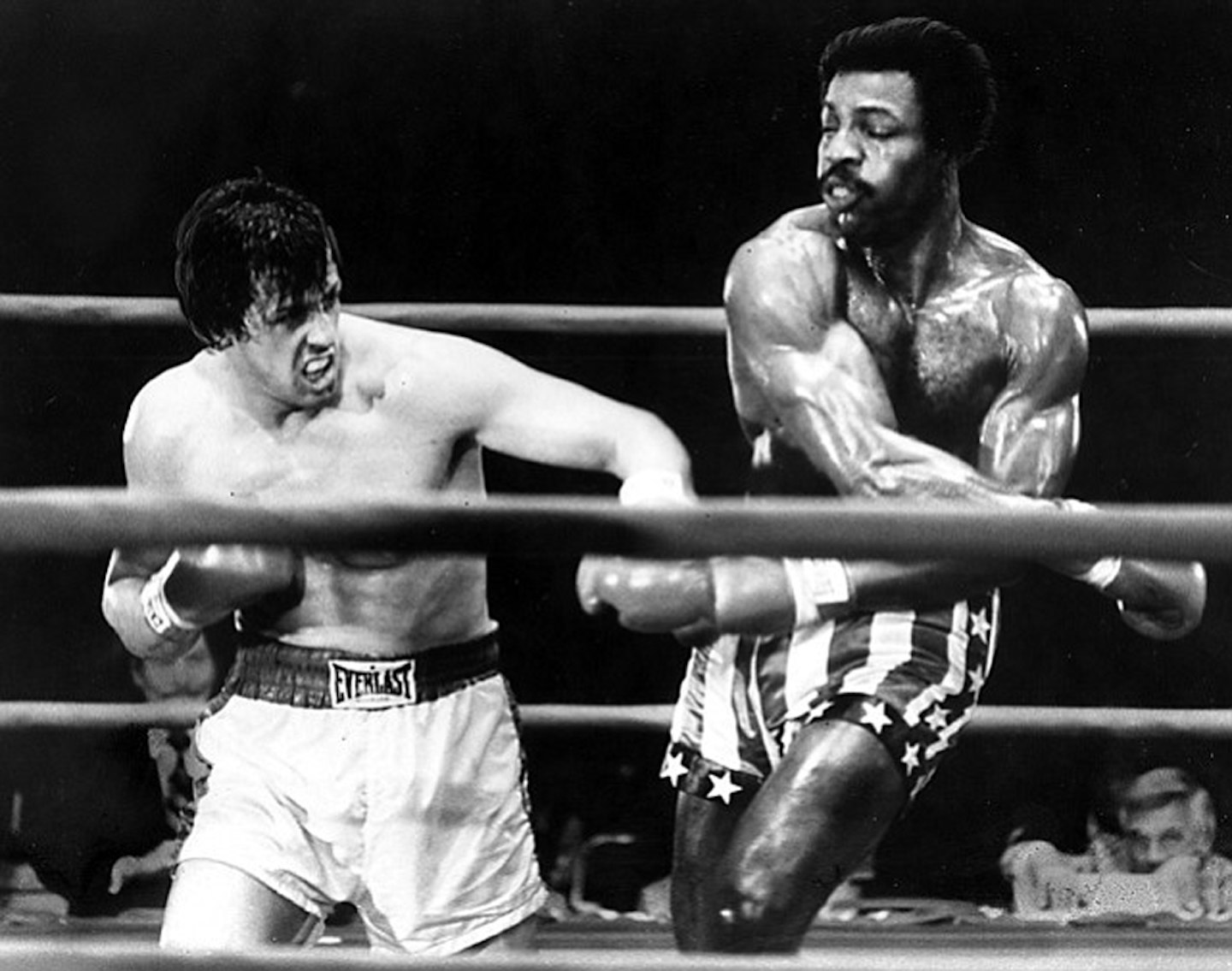
Conrad: As you were cutting it together, you could see that the fight was looking very realistic. All of the camera shots – all of the different angles – helped us to make something very realistic out of it. We had a lot of cutaways to Burgess and the corners. It was also the first time that the Steadicam was ever used. A lot of the shots inside the ring that were moving and going around are hand-held Steadicam shots. Also, if you look very carefully, you’ll see that there’s no one in the audience. John Avildsen was out of time. I think they had given him two days to shoot in with a crowd, and they went into a third day and had virtually nobody in the audience. My task was to keep it moving and keep your concentration so that you would be looking at the figures in the center of the screen and not looking behind them, especially if there was nobody there. It’s blacked out, but if you look very hard you can tell that there’s nobody there.
Chartoff: Stallone really choreographed it and Avildsen shot it. We did it with a very small budget, we had very few extras in the stadium to work with most of the time. Shots had to be done carefully. In the end, no one had really tried a fight film like that one before and we just hoped it would work. It was pretty clear that it would. That fight was rehearsed for literally months; it wasn’t like it just magically came together. Every shot was choreographed, revised, examined and considered before it was placed in the film.
ROUND SEVEN: THE ORIGINAL ENDING
Conrad: Originally, when the stadium clears, Rocky walks out by the grand stands with Talia Shire, and Spider Rico, who he fights in the first fight in the movie in the church, is there and he says, “Yo, Rock, you fought a good fight,” and Rocky says, “Yeah, yo,” and he walks off with Talia down the aisle and that was it. To me, this just didn’t do it. If I just went 15 rounds of a heavyweight fight and got my brains beat out, I’d sure as hell want more than this. I told Avildsen that I thought we should reshoot the ending, Talia should come into the ring and there should be a whole mob and it should be a close decision. He said, “I’d love to do that, but I’m out of time, they’re out of money and they won’t let me do it.” In our weekly meeting with Chartoff and Winkler, I brought up the idea. John wasn’t there, he was late that day. I felt that I was doing him a favour and he had agreed he liked it. Chartoff and Winkler loved the idea and agreed to do it. We ended up going down to the Olympic Auditorium with some extras and a lot of close shots and it worked out beautifully.
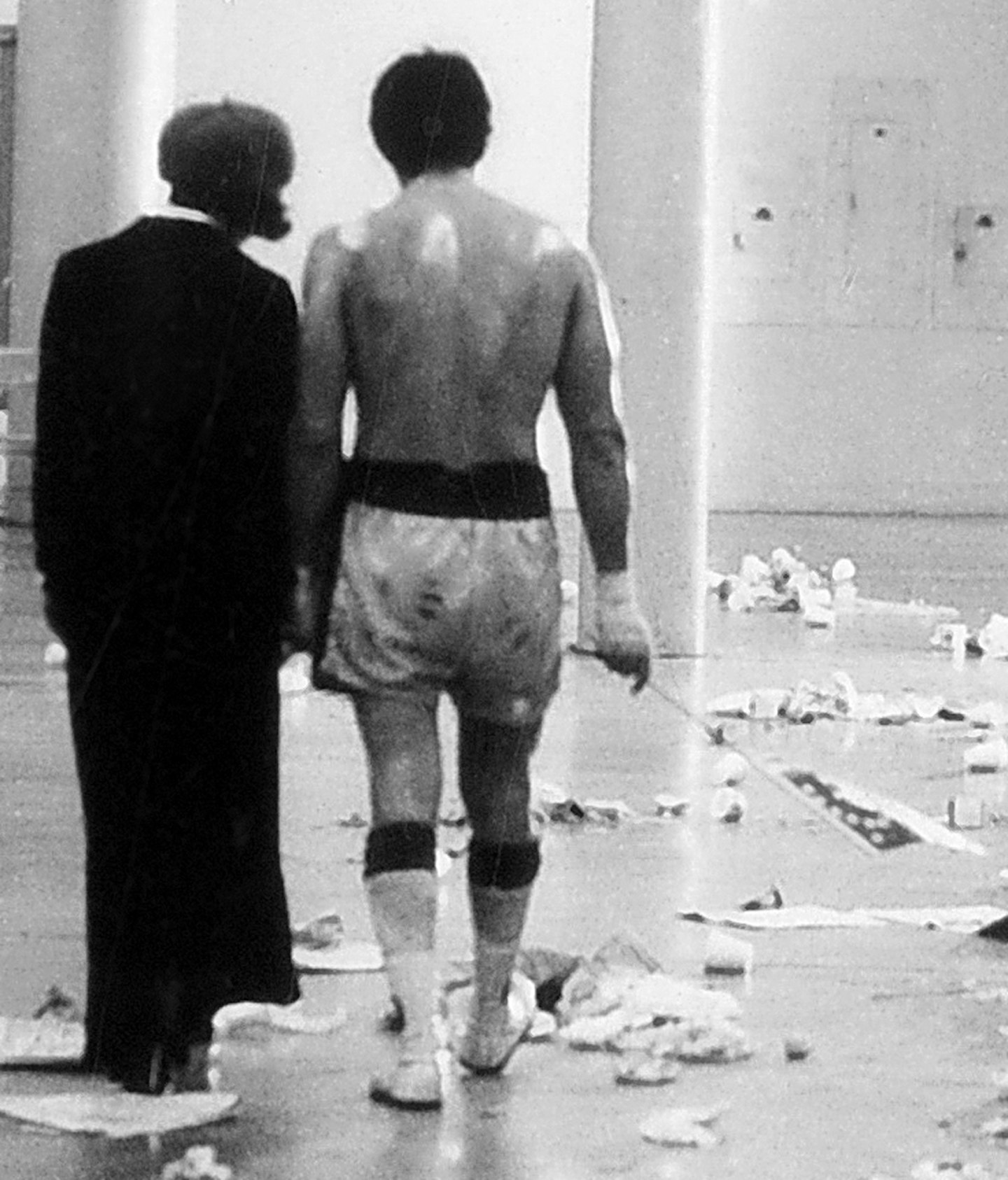
Halsey: Avildsen had shot this sort of storybook ending, where Rocky walks out of the stadium and we had this hokey kind of Rocky folklore song. It was horrible. In the cutting room we sort of decided that what we needed to do was end the movie in the ring. We did a day of pick-ups and I think we used some extras and the producers laid off the cost on New York, New York which they had going at the same time. So we did this day of pick-up shots so we could end the movie within the ring. What we had was the fight is ending, Adrian is backstage, she comes forward and we deal with the love story and the end of the fight at the same time. And we don’t really hear what’s going on that well - did he really win or lose? It’s very chaotic and even in the mix I said, “Jesus, we never had a really good shot of Apollo Creed holding his fist in the air like he was the winner.” If you look at the movie, though, you can see one little shot of it. The whole point was Rocky went the 15 rounds so he was a winner, even though he lost the fight.
Avildsen: Originally, it ended with Apollo being carried out and then Rocky being carried out, or at least Adrian was at the end of the aisle and he picked her up. I think the last sentence in the script was, “They went off to the happiest night of their lives.” So we shot the crowd carrying Apollo and the AD said, “We don’t have anybody to carry out Rocky.” Obviously we were going to have to use the same people, so that wasn’t going to work. Sylvester heard that and said, “Maybe nobody carries out Rocky.” So Sylvester came up with an ending where Rocky just walks down the aisle by himself, then he and Adrian just walk off together. I said, “Gee, that sounds good, why don’t we do that?” If you remember the poster for the first picture had the boy and girl walking away from camera. That’s what we shot.
Then I started cutting the picture together. I had shown the 8mm movie to Bill Conti, who I had gotten to do the music. I played some of Beethoven’s Sixth Symphony, because we wanted to lift boxing up and put it into another realm, and that’s the kind of music that I wanted. That’s what he started working on. When I had it all put together and had Bill’s music for the last cue, I said, “Gee, I don’t have any pictures to go with this; this is inspiring and majestic. The boy and girl should be rushing together, not walking away. Why don’t we do that? Why don’t we reshoot that and let Adrian run to the ring and fight through the crowd and jump in there and say, ‘I love you,’ because that’s the music we’ve got. Let’s not write the music for the film we’ve got, let’s shoot the film for the music we’ve got because the music is terrific.” Martin Scorsese was doing New York, New York for the same producers and he had all his equipment lined up because they were going to shoot in a day or two. So we borrowed the equipment for half a day and went back to the Sports Arena with about 20 extras to stand in front of the camera to look like a crowd, and we shot that ending which worked great with the music. And it was the perfect end for the movie.
ROUND EIGHT: SUCCESS
Avildsen: The only time you realise that you’ve got something special is after you’ve shown it to a couple of audiences. We did that on Rocky, but when we showed it to an audience we had everything except the last reel, where the majority of the final fight was. We showed that to a couple of universities. People had a nice reaction to it and were anxious to see what happened. It took a while to get that last reel. When we did, I invited about a hundred friends to a screening of it at United Artists and showed it for the first time, and at the end they cheered and got out of their seats. I had never seen a reaction like that. When I came out of the theatre, the producers were there and I jokingly went up to them and said, “Well, we’ve got a lot of work to do.” They said, “Yes, Yes,” and I realised that they were serious. They wanted to make it better. I realised that we would have to show it right away to a room full of strangers so they wouldn’t think that my friends were just being kind. So we put together a screening for 400 strangers and the reaction was the same. At that point, they decided not to make any changes and the film went on to do what it did.
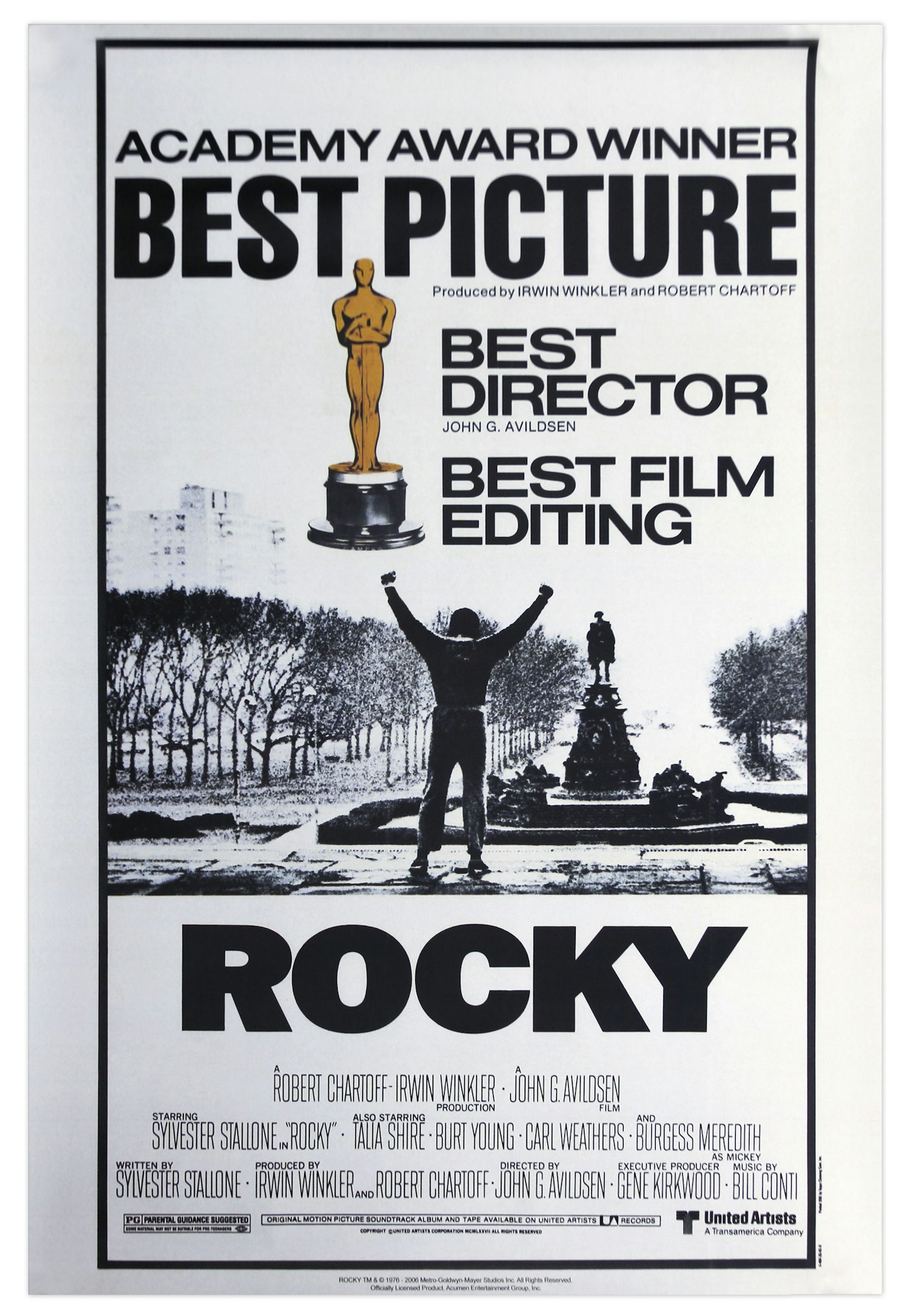
ROUND NINE: OSCAR NIGHT
Chartoff: For months before that, everyone was telling us that we were going to win, so we kind of believed it. Except for Academy Award night itself when Peter Finch won for Network. When he won it, I thought Network was going to sweep the night. In a sense, though, that made it sweeter, because for ten or 15 minutes I really thought we had lost the competition. But we didn’t and it was a great thrill.
Conrad: Hey, that was my 15 minutes of fame. It was one of the most important, wonderful, enjoyable nights in my life and I’ll never forget it. Richard Halsey’s mother had taped the awards and I didn’t know it for years. When they first announced the editing award – William Holden did the presentation – he said, “The winner is...” and since there were two of us we knew we didn’t get it, and there was this letdown feeling. Then Holden said, “Pardon me, the winners are…” and at that moment it became one of the most memorable nights of my life.
Avildsen: There wasn’t any anticipation. Rocky was the perfect fairy tale, and for us, too. The whole Academy Awards thing was a shock. I did not think I was in that club, so that turned out to be a most amazing surprise.
ROUND TEN: THE AFTERMATH
Chartoff: I guess I was involved with about 35 films and the Rocky films were a part of that list. I loved making each one of them, and I feel that about most of the pictures I made. Certainly the Rocky films have a very special place in my heart, not only because it won the Academy Award, but because of the challenge of having to make it the way we did. And the audience loved it so much; it’s become part of our mythology and our lexicon. I’m proud of it.
Conrad: The first time we cut the whole film together, I don’t think anybody knew that it would go on to do what it did, but we all knew we had something very special there. As a matter of fact, one of the reasons I was brought on was that Chartoff and Winkler wanted to get it ready for the Cannes Film Festival. That was the big rush. But when we saw what was there, they realized that rather than rushing it and hurting it, they should skip Cannes and try to do the best job they could. Which I think was a very wise decision on their part, and not one that happens very often today.
Weathers: I’m amazed that the series has gone on the way it has. Never in my wildest dreams did I think I would have been playing Apollo ten years later. I’m recognised all over the world because of them. That’s what the cosmos has presented and I’m just happy I’m the person it was presented to.
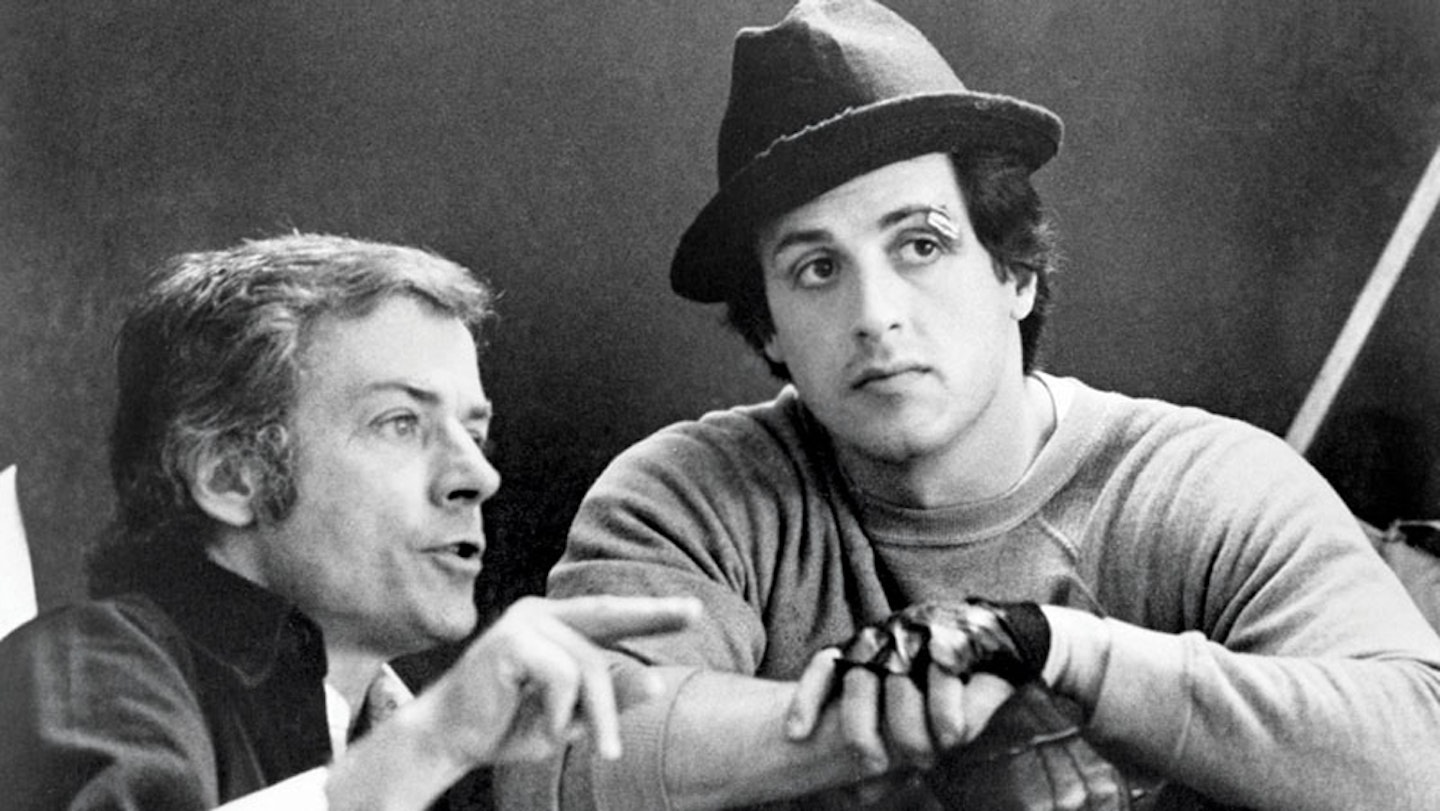
Avildsen: The continuing popularity of the film surprises and delights me. I never thought, at the time we were doing it, that it was a film we would still be discussing 40 years later. We thought it was going to be on the bottom bill of a drive-in in Arkansas or something.
Additional sources: Access Hollywood, The Official Rocky Scrapbook, Playboy
